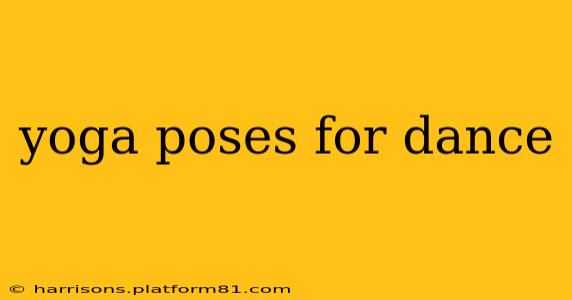Dance and yoga may seem like disparate disciplines, but they share a surprising synergy. Both demand flexibility, strength, balance, and body awareness. Incorporating specific yoga poses into your dance training can significantly enhance your performance, preventing injuries, and improving your overall artistry. This guide explores key yoga poses that dancers can utilize to elevate their skills.
What are the benefits of yoga for dancers?
Many dancers find yoga to be a game-changer in their training. The benefits extend beyond simple flexibility, contributing to a more powerful and controlled performance. Yoga improves:
- Flexibility and Range of Motion: Essential for executing complex movements and achieving graceful lines.
- Strength and Endurance: Yoga builds core strength, leg strength, and overall muscular endurance, vital for longer performances.
- Balance and Coordination: Improves proprioception (body awareness), leading to better control and stability.
- Injury Prevention: Strengthens supporting muscles, reducing the risk of strains and tears.
- Mind-Body Connection: Enhances focus, concentration, and the ability to control and express emotions through movement.
- Increased Breath Control: Crucial for stamina and expressive movement.
Yoga Poses for Flexibility and Range of Motion
These poses directly address the flexibility demands of dance, targeting key muscle groups used in various dance styles:
1. Forward Fold (Uttanasana):
This classic pose lengthens the hamstrings, calves, and spine – crucial for leg extensions and graceful movements. Hold for 30 seconds to a minute, focusing on lengthening the spine with each exhale.
2. Triangle Pose (Trikonasana):
Stretches the hamstrings, groins, and hips, improving the flexibility needed for turns, leaps, and other dynamic movements. Maintain a straight spine and engage your core throughout the pose.
3. Low Lunge (Anjaneyasana):
This pose opens the hips and groin, improving flexibility for splits, jumps, and dynamic floorwork. Focus on lengthening the spine and deepening the stretch in the hip flexors.
4. Pigeon Pose (Kapotasana):
A deep hip opener that targets the glutes and hip flexors, crucial for improving turnout and range of motion in the legs. Beginners can modify by placing a blanket or block under their hips for support.
5. Butterfly Pose (Baddha Konasana):
Opens the inner thighs and groin, essential for flexibility in dance movements that require wide leg positions. Gently press down on your knees to deepen the stretch.
Yoga Poses for Strength and Core Stability
Strong core muscles are fundamental to controlled and powerful movements in dance. These poses build core strength and stability:
6. Plank Pose (Phalakasana):
Engages the entire core, strengthening the abdominal muscles and improving postural alignment. Hold for 30 seconds to a minute, ensuring your body forms a straight line from head to heels.
7. Boat Pose (Paripurna Navasana):
Works the abdominal muscles, hip flexors, and back muscles, providing greater stability and control in dynamic dance movements. Start slowly and gradually increase your hold time.
8. Warrior III Pose (Virabhadrasana III):
This balancing pose requires core strength and stability while engaging leg muscles. It improves balance and coordination, key elements for controlled movements.
Yoga Poses for Balance and Coordination
These poses challenge your balance and proprioception, leading to improved coordination on the dance floor:
9. Tree Pose (Vrksasana):
Improves balance and focus, essential for maintaining control during complex dance sequences. Start with your eyes open and gradually close them as you become more stable.
10. Half Moon Pose (Ardha Chandrasana):
A challenging balancing pose that strengthens core muscles and improves stability, aiding in controlled and graceful movements.
How Often Should Dancers Practice Yoga?
The frequency of yoga practice depends on individual needs and dance schedules. Aim for at least 2-3 sessions per week to see noticeable improvements in flexibility, strength, and balance. Even shorter, focused sessions can be beneficial when incorporated into a warm-up or cool-down routine.
What type of yoga is best for dancers?
While any style of yoga can be beneficial, styles emphasizing flexibility, strength, and alignment such as Hatha, Vinyasa, or Iyengar are particularly well-suited for dancers.
Remember to listen to your body and modify poses as needed. Consult with a qualified yoga instructor or physical therapist for personalized guidance and injury prevention. By incorporating these yoga poses into your training regime, you can unlock a new level of performance and artistry in your dancing.
